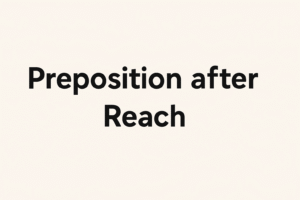Can a Preposition Follow “Reach”?-Grammar Puzzle Solved (4)
The verb “reach” often causes confusion when it comes to using prepositions. Many learners ask whether it is correct to say “reach at,” “reach in,” or “reach to.” The answer depends on the structure and meaning of the sentence, as well as whether “reach” is used literally or figuratively. So, is it ever grammatically correct to use a preposition after “reach”? Let’s explore this grammar puzzle clearly and logically.
Basic Rule of ‘Reach’
When “reach” means “to arrive at” or “to make contact with,” it functions as a transitive verb, meaning it takes a direct object without a preposition.
Correct:
-
She reached home before sunset.
-
I couldn’t reach him by phone.
-
They reached the top of the mountain.
In these examples, you do not need a preposition after “reach.” The verb directly connects to its object.
When Prepositions Are Used
Even though “reach” usually doesn’t require a preposition, there are situations where a prepositional phrase is appropriate — but not immediately after “reach.” Instead, the preposition comes after the object to describe the manner or location of the action.
Examples:
-
He reached into his bag to grab a notebook.
-
She reached for the glass on the shelf.
-
The cat reached under the couch for the toy.
In these examples, the verb “reach” is followed by a prepositional phrase that modifies how or where the reaching action happens. The object is not a person or place but rather the direction or container of the action.
Incorrect Usage
Incorrect:
-
❌ He reached at the door.
-
❌ We reached to the station.
These are incorrect because “reach” in the sense of arrival or contact does not take “at” or “to.” You simply say, “He reached the door” or “We reached the station.”
Figurative Use and Idioms
In some idiomatic or figurative expressions, prepositions follow “reach,” but not in the literal “arrive at” sense:
-
She reached out to her friend. (Meaning: to offer help or communication)
-
The policy aims to reach into every community. (Meaning: to influence or affect)
These usages are idiomatic, and the meaning shifts based on the preposition.
Conclusion
To sum up, the verb “reach” generally does not require a preposition when used with a direct object, especially in the sense of arrival or making contact. However, prepositions may be used as part of a prepositional phrase to describe the action more precisely or in idiomatic expressions. Understanding the function of “reach” in context helps determine whether a preposition is appropriate.

Use of Since and For:
https://grammarpuzzlesolved.englishlitnotes.com/since-and-for-in-english-grammar/
Sir Alexander Fleming by Patrick Pringle:
https://englishwithnaeemullahbutt.com/2025/06/02/alexander-fleming/
Thomas Paine as a Revolutionary American Writer:
https://americanlit.englishlitnotes.com/thomas-paine-revolutionary-american-writer/
Social Corruption and Justice in Piers Plowman:
https://englishlitnotes.com/2025/06/07/social-corruption-and-justice-piers-plowman/
Visit ChatGPT to explore the platform and interact with the AI: https://chat.openai.com
Discover more from Grammar Puzzle Solved by Naeem Ullah Butt
Subscribe to get the latest posts sent to your email.